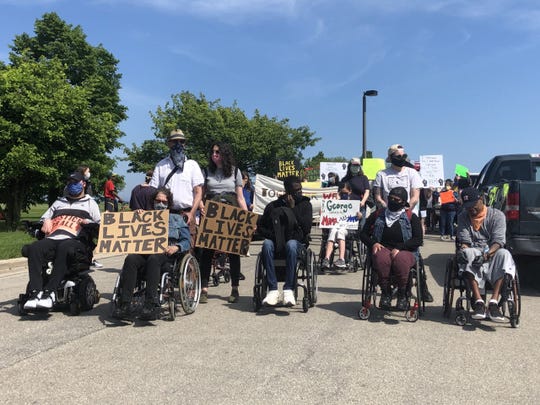

Black Lives Matter protest by disabled activists, June 7, Milwaukee.
Because most of the mass protests held after the police murder of George Floyd were not accessible, on June 7 Black disabled activists in Milwaukee held their own. The Milwaukee action was the second George Floyd protest held by Black disabled activists. The first was held in Washington, D.C., where marchers shouted “Sign his name,” referring to George Floyd, to demand sign language interpretation accessible to people with hearing disabilities who communicate via sign language.


Black Lives Matter protest by disabled activists, June 7, Milwaukee.
Black disabled organizer Harvey Ross wants people to understand that people of color with disabilities are at higher risk of police violence. Ross said: “We are being policed and governed by incompetent people who can’t do their jobs, so we want their resignations. I have had police officers pull me over with guns drawn and ask, ‘Why do you have gloves on?’” Ross wears gloves when he drives because of his disability. (Milwaukee Journal Sentinel, June 7)
Disability rights journalist David M. Perry, whose son has Down syndrome, documented, in research for the Ruderman Family Foundation, that as many as half of all people killed by police have a disability. (tinyurl.com/y7hau3fu)
In a June 15 WNYC radio podcast on “The Takeaway,” “The Overlooked Reality of Police Violence Against Disabled Black Americans,” Amy Walter spoke with African American disabled activist Haben Girma, author of “Haben: The Deafblind Woman Who Conquered Harvard Law.” She said: “When we talk about police violence . . . and when we don’t comply because we didn’t hear the command, or we can’t move in a certain way, or we don’t see a physical gesture, or maybe there’s an invisible disability like a psychiatric disability, then the noncompliance is interpreted as threatening.
“Right now the definition of protest is very able-bodied; it’s a physical standing up in the street holding signs. There are many different ways to protest. There are disabled people who are protesting in the streets using wheelchairs or other assistive devices. There are disabled people protesting from home through social media, through calls to their representatives, so we should expand the definition of protest. We also need to make sure the physical and digital protests are accessible. Content online needs to have captions, sign language interpreters and images need to also include image descriptions.”
Accessibility was a priority at the Milwaukee protest. Activists picked out the route with the least amount of hills for those using manual wheelchairs and other mobility devices. Rest stops along the way were staffed by medics who issued supplies such as water and ear plugs. American Sign Language interpreters were present throughout and taught marchers how to sign “Black Lives Matter.” Protesters were encouraged to wear masks and observe social distancing. Many had masks with clear plastic covering the mouth, so people with hearing disabilities could read their lips.
Hundreds of protesters then marched to Red Arrow Park to remember Dontre Hamilton, a person with a schizophrenia diagnosis who was killed in 2014 when police shot him 14 times. Teighlor McGee, who runs an online platform called the Black Disability Collective and who grew up in Mequon, Wis., said that protests after Hamilton’s death were the first she had participated in when she was 16. “Seeing this accessible protest brings tears to my eyes,” she said on Twitter.
History of accessible protest
The recent endeavor to hold accessible protests is not without historical precedents. In October 1981, 3,000 people took part in the All Peoples Congress at wheelchair-accessible Cobo Hall in Detroit, voting overwhelmingly for “National Days of Resistance” to overturn Ronald Reagan’s program of cutbacks and attacks on labor, racism, sexism, ableism, LGBTQ2S+ oppression and war. In the Oct. 23, 1981, issue of Workers World the late Betsy Gimbel — a wheelchair user, Disabled in Action Secretary and WWP Disability Rights Caucus leader — described how the Disabled Focus workshop at the APC unanimously voted to support the Days of Resistance the following year and proposed that all actions be made accessible for people of all disabilities.
Gimbel, who helped lead the successful struggle for wheelchair lifts on New York City buses, explained how many of the APC organizers had worked to make the 100,000-strong May 3, 1981, march on the Pentagon against war, racism and cutbacks accessible. Gimbel told WW: “May 3 opened the door for the first time in history to disabled people — and now it’s up to disabled people themselves to walk through that door.”
Hamas issued the following statement on April 24, 2025, published on Resistance News Network. The…
By D. Musa Springer This statement is from Hood Communist editor and organizer D. Musa…
Portland, Oregon On April 12 — following protests in Seattle and elsewhere in support of…
This statement was recently issued by over 30 groups. On Friday, March 28, Dr. Helyeh…
When Donald Trump announced massive tariffs on foreign imports April 2, Wall Street investors saw…
The century-long struggle to abolish the death penalty in the U.S. has been making significant…